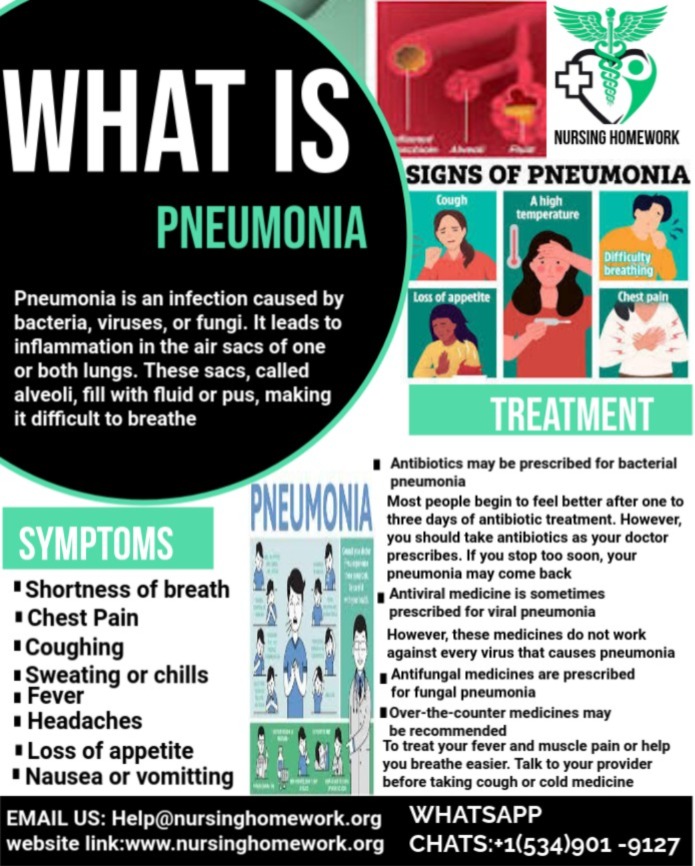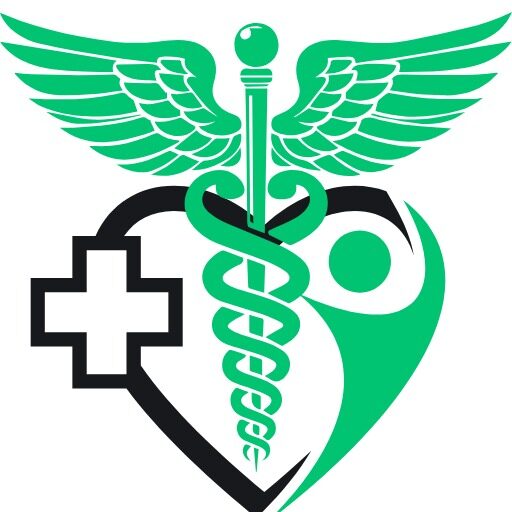Email Us: help@nursinghomework.org | Whatsapp Chats: +1 (534) 901-9127

Pneumonia homework help
Get professional guidance or pneumonia homework help for an enriched understanding of pneumonia as a health concern affecting people of different ages. Pneumonia is among the prevalent diseases among children. However, it affects people of different ages, including young adults and older people. Pneumonia is a health problem whereby the affected individual experiences inflammation of the lungs. The inflammation is always the result of an infection caused by fungi, bacteria, or viruses. Apart from inflammation of the lungs, the affected individual can also develop fluid in the lungs. A combination of the inflammation, which results in swelling of the lungs, and presence of the the fluid in the lungs, causes breathing difficulty to the person. It may also result in coughing and fever. Cough in an individual with pneumonia is unique in that a person releases bloody, green, or yellow mucus. Apart from the pathogens, pneumonia can also result when a person suffers from pneumococcal disease, COVID-19, or flu. The various causes of the disease determine the type of pneumonia. For instance, pneumonia caused by a virus is known as viral pneumonia, while bacteria cause bacterial pneumonia. Once affected, one or both lungs can be affected.
Different types of pneumonia
There are different ways of classifying pneumonia. It can be characterized based on the causal agent and also how a person obtained the infection. With the various types of pneumonia that exist, it is important to have a basic understanding of each of the health conditions. Depending on how an individual obtained the infection, pneumonia types include ventilator-associated pneumonia, hospital-acquired pneumonia, and community-acquired pneumonia. However, the disease can be categorized as fungal, bacterial, or viral, depending on the causal agent.
| Types of pneumonia | Community-acquired pneumonia | Hospital-acquired pneumonia | Ventilator-associated pneumonia | Fungal pneumonia | Bacterial pneumonia | Viral pneumonia |
| Cause | Acquired outside healthcare facility | antibiotic-resistant bacteria, e.g., methicillin-resistant Staphylococcus aureus (MRSA) | Caused by either bacteria, viruses, or fungi | Coccidioides, Pneumocystis jirovecii, Cryptococcus
Coccidioidomycosis) |
Chlamydia pneumoniae
Streptococcus pneumonia Mycoplasma pneumonia |
SARS-CoV-2
Some common cold and flu viruses Respiratory syncytial virus (RSV) |
| Complications | Systemic complications, e.g., septic shock
Respiratory failure Death Lung complications |
Lung abscess
Sepsis Respiratory failure Longterm lung damage |
Empyema
Bronchospasm Septic shock Acute respiratory virus syndrome |
Sepsis syndrome
Cerebral septic emboli Hemoptysis Pulmonary infarction |
Meningitis, sinus infections, ear infections | Heart failure
Liver failure Respiratory failure
|
For profound explanation on the various categories of pneumonia, our pneumonia homework help tutors are standby to work on your request.
The population at high risk of developing pneumonia
As earlier stated, anybody is at risk of getting pneumonia. However, there are people at a higher risk of developing the disease. Based on age, children below the age of two and the elderly of more than 65 years are highly predisposed to the disease.
Generally, pneumonia specifically targets the lungs. Therefore, people with lung complications are also vulnerable to the disease. Research also shows that individuals diagnosed with heart complications can easily contract pneumonia. Some of the diseases that increase one’s risk of getting pneumonia include sarcoidosis, pulmonary fibrosis, emphysema, asthma, cystic fibrosis, and chronic obstructive pulmonary disease.
Individuals with extended hospital admissions or spend in a long-term care facility are predisposed to the risk of contracting pneumonia, especially healthcare-acquired pneumonia.
Another category of people at high risk of pneumonia are smokers, pregnant women, and also individuals with weak immune systems. A weak immune system can be associated with chemotherapy and related cancer treatments, individuals relying on medications whose side effects include suppression of the immune system, and also individuals living with HIV/AIDS.
Suggestive signs and symptoms of pneumonia
Lung-related diseases may sometimes have similar symptoms, which can easily be confused with pneumonia. Any confusion between the health problems requires performing tests or diagnosis to determine the actual problem a patient suffers from.
There are different types of pneumonia, and there are also different signs and symptoms. The age of the individual affected also affects the type of symptoms they experience.
The main signs and symptoms of the disease among the elderly include fatigue, low appetite, and a sudden change in mental health. Besides, one may experience breath shortness and cough. Because of the weak immune system, the disease can worsen and become life-threatening.
Once they develop pneumonia, children experience multiple signs and symptoms, including vomiting, loss of appetite, breathing difficulty, coughing, sweating, chills, and fever. With inflamed or swollen lungs, a child may present with poor feeding, noisy breathing, and increased crying from the resulting discomfort.
How can you differentiate viral and bacterial pneumonia?
Bacterial pneumonia is known for its multiple symptoms, such as chills or sweating, breath shortness, rapid breathing, high fever, coughing green, yellow, or bloody mucus, bluish nails, lips or skin, loss of appetite, and chest pains. The symptoms can develop immediately or gradually after the time of infection.
Viral pneumonia shows symptoms several days after the infection. A person may experience extreme body fatigue or weakness, muscle pain, headache, and dry cough.
If you realize a patient displaying additional symptoms of which you suspect to be pneumonia, seek professional direction through getting our online pneumonia homework help.
Pneumonia transmission
As an acute respiratory infection, it is important for healthy individuals and also affected parties to understand the transmission mechanisms of the disease. The pathogens causing the disease attack the lungs but are mostly present in a person’s throat or nose and, hence, cause an infection through inhalation. However, when an affected person sneezes or coughs, the disease-causing organisms can be transmitted through the air droplets. A parent, specifically the mother, during pregnancy and at birth, can transfer pneumonia to the child during birth or some moments after birth.
Awareness of the modes of transmission is important to lower the spread of the disease. Hence, the healthy and infected population can take necessary precautions for a healthy population.
Tests and diagnosis for pneumonia
| Test | Procedure involved |
| Sputum test | A sputum sample extracted from the lungs is used to diagnose infections within the lungs. Any abnormality in the sputum sample indicates a positive sputum test. |
| Bronchoscopy | A bronchoscope is used to examine the airways in the lungs. The process involves tissue biopsy, sputum collection, and extracting the fluids within the lungs to test for any disorders. |
| Imaging, e.g., chest CT scan and chest X-ray | Chest x-ray helps to show the presence of lung inflammation.
A CT scan helps to identify the detailed image of the lungs. It is more effective when the chest X-ray fails to give detailed or reliable information. |
| Blood test | It helps to identify the cause of infection and shows the extent to which the virus, fungi, or bacteria has spread in the blood. |
| Arterial blood gas test | Diagnoses pneumonia through assessing the pulmonary ventilation. |
| Pulse oximetry | It helps measure oxygen levels in the blood. An oxygen saturation below 92% indicates pneumonia. |
There are various procedures involved in each of the tests. Don’t mess up when you can improve your knowledge on test and diagnosis of pneumonia by getting our grade-one pneumonia homework help writing services.
Treatment of pneumonia
Pneumonia is treatable once the cause is identified. Hence, a caregiver should consider the results of the diagnosis or test to determine the most suitable and effective treatment. Treatments vary depending on the cause of the disease.
Therefore, antibiotics are used when an individual suffers from bacterial pneumonia. However, the medication is not effective when used on an individual with viral pneumonia.
Is pneumonia preventable?
Such a question is possible for a victim of the disease and also for individuals aware of the health risks of the disease on an individual.
The good news is pneumonia is preventable.
Among the possible ways of preventing infection is through immunization against various diseases, such as whooping cough, measles, and pneumococcus, which can put a person at risk of the disease.
Caregivers or parents can prevent the disease among children by promoting good nutrition to boost their immunity. Good nutrition also improves an individual’s recovery rate once infected.
When air pollution is among the main causes of disease, an individual can prevent the disease risk by limiting exposure to air pollutants while promoting improved hygiene in their residential places.
UNICEF and WHO recommend and approve such preventive approaches, as strategies for protecting, preventing, and treating pneumonia.
Additional ways of lowering the risk of pneumonia are refraining from smoking habits and also from exposure to secondhand smoke to avoid lung damage, making it vulnerable to infections that can result in pneumonia.
For any related information to improve your understanding of pneumonia and how to handle patients with pneumonia, get expert assistance by registering for our pneumonia homework help online.
Management of pneumonia symptoms
At times, serious symptoms of pneumonia can result in significant discomfort and reduced life quality. In this case, the patient can use different approaches to manage the symptoms. The choice of the intervention varies depending on the symptom and its severity. For instance, if an adult experiences dry cough or any type of cough while having pneumonia, they can use cough suppressants, which can clear the mucus or any fluids accumulating in the lungs through coughing.
Other approaches to managing the symptoms include drinking adequate fluids, using a humidifier to improve breathing ability, and engaging in breathing exercises to loosen mucus and, therefore, encourage improved breathing. Painkillers can help when a pneumonia patient experiences fever or body aches. In this case, they can use acetaminophen or ibuprofen, among other painkillers.
Why prefer us
Nursing homework writers are professional nursing tutors offering top-quality pneumonia homework help to students at both college and university levels. It can be the wish of almost all nursing students just to learn without any form of assessment due to the pressure they face of researching and reading extensively to ensure they score better grades. Unfortunately, nursing assessments and homework are unavoidable parts of a nursing student’s academic journey.
However, you can engage our tutors to help you complete your nursing homework questions and also get nursing homework samples to guide you.
Don’t hesitate to contact us for the best quality, affordable, and convenient nursing homework help solutions.
